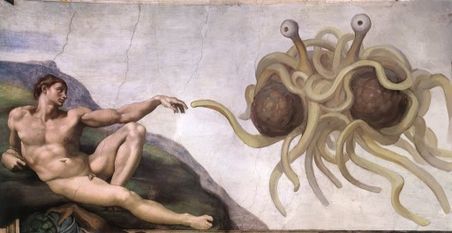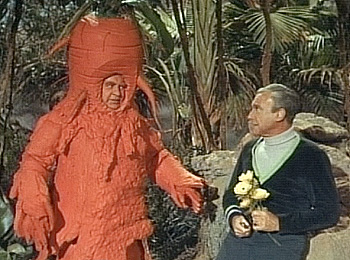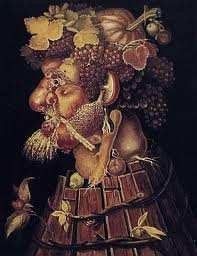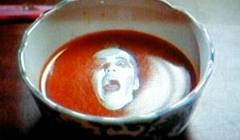The 20 Most Bizarre Fictional Food Characters
 |
Opening this Friday, the animated feature Cloudy With a Chance of Meatballs 2 presents a vast array of anthropomorphic and sentient creatures made up of food, from pizzas with crust limbs, musical burgers and cute little strawberries to predatory “Tacodiles.” At the other end of the wholesomeness scale, Seth Rogen and Evan Goldberg are gearing up to produce their long-cherished project Sausage Party, an R-rated, animated adventure about a sausage that’s fallen from his shopping cart and is trying to get back to his aisle.
But of course, there’s nothing new in this.
Humans have been endowing our food with personality since at least the Gingerbread Man – revived as Gingy in the Shrek movies – through innumerable advertising favorites ranging from Big Fig – the dancing Fig Newton – to Mayor McCheese, Will Vinton’s California Raisins, the gullible M&Ms, the evangelical stars of the Veggie Tales and the Aqua Teen Hunger Force. Here are twenty more of the many, many other examples of conscious cuisine…
1. The Flying Spaghetti Monster
 |
The FSM was created by – or, perhaps, revealed himself to humanity through – one Bobby Henderson, in a 2005 open letter to the Kansas State Board of Education arguing against teaching “Intelligent Design” in public school science classes, on the grounds that there’s as much scientific evidence that this high-carbohydrate deity created the universe as any other Supreme Being. Soon after, however, the Sacred Starchy One spawned books, a website, and other manifestations, and, in a sort of apotheosis et absurdum, was adopted by ironic hipsters as their true faith.
It’s all good-natured fun for now. Hopefully a few centuries hence there won’t be a bloody jihad between the Orthodox FSMers and the sect of the Al Dente Angel Hair Incarnation.
2. Mr. Potato Head
 |
Back a few decades ago when he was still funny, Jay Leno once did a routine about how Americans could use Mr. Potato Head as a key to understanding why people in other countries hate us: You show a starving third-world kid a potato, then explain to him that it’s not for him to eat, it’s for him to put a little hat on.
Turns out that even mid-20th Century Americans, raised on the parental commonplace “don’t play with your food,” were uncomfortable with the waste implied by the original Mr. Potato Head, invented by one George Lerner in the late ’40s and mass-produced by Hasbro in the early ’50s. The original set included only the plastic eyes, nose and other features, intended to be stuck into a real spud. A few years later Hasbro decided that it was less wasteful and safer to make a fake, hollow potato body for him out of petroleum products. Yay! In this form he became a classic resident of the American toy box; along with the Slinky Dog and Barbie, one of the handful of real-life toy brands to be included in the Toy Story universe.
3. Mattel Food Fighters
This 1988 action figure line of comestible warriors from Mattel included both the “Kitchen Commandos” like Burgedier General, Major Munch (a donut) and Private Pizza, who traveled in the Combat Carton (an egg carton assault vehicle), versus the “Refrigerator Rejects” like Mean Wiener, Short Stack and Taco Terror. They didn’t quite dethrone Mr. Potato Head in the field of food toys. But they got to star in a rather cool stop-motion commercial, which has an even more epicurean flavor when heard, as it is on YouTube, in French.
4. The Killer Tomatoes
“I know I’m going to miss her/A tomato ate my sister/Sacramento fell today/They’re marching on San Jose” These couplets from the notorious theme song give a pretty solid indication of the level of wit in John DiBello’s 1978 indie sci-fi spoof Attack of the Killer Tomatoes. Nonetheless, the franchise has proven more durable than the average tomato, spawning a cartoon, video games and a comic book. There have also been a number of imitators, including a 1999 Greek effort, Attack of the Giant Moussaka, with really convincing special effects.
The time has come, however, for some enterprising boy band to cover “Puberty Love,” the song that is the Achilles heel of the tomatoes. It could have been a hit for One Direction, but the moment has passed.
5. Pizza the Hutt
Only a few notches higher than Attack of the Killer Tomatoes in terms of sophistication – a few important notches, admittedly – is the humor in Spaceballs, the 1987 Mel Brooks send-up of Star Wars. The movie’s equivalent of Jabba the Hutt, this talking slice of pizza (voiced by Dom DeLuise) with a Godfather-style gangster persona is also, despite the silliness of the context, quite an effectively nauseating special effect, bubbling and dripping with tomato sauce (one hopes) and melted cheese (one hopes).
It may not be advisable to rent this movie on Pizza Night. Indeed, Pizza Night may be postponed for a few weeks after this one.
6. The Tennis-Playing Alien Blancmange
It’s probably the only story of an alien invasion in which the invaders were sentient milk-and-cornstarch puddings, and almost certainly the only one in which the aim of the invaders was to win a tennis tournament. This sublime 1969 edition of Monty Python’s Flying Circus, titled simply “Science Fiction Sketch,” was a rare example, on that show, of a nearly complete-episode narrative.
The blancmanges, natives of the planet Skyron in the galaxy Andromeda, transform most of the population of England into Scotsmen (one newspaper headline reads “Man Turns Into Scotsman”) on the theory that this will somehow neutralize them as tennis competition. This is important because…well, first let’s employ the Monty Python version of a “spoiler alert”: “Those of you who wish to play it the hard way, stand upside down with your head in a bucket of piranha fish…” “THEY MEAN TO WIN WIMBLEDON.”
7. Matango
One of Toho’s freakiest and most startling efforts, this 1963 film, based on a creepy 1907 story by William Hope Hodgson, is about the title species of fungus, discovered by shipwrecked and hungry castaways marooned on an island. It’s addictively yummy, but if you partake of it, you soon learn the true meaning of “You are what you eat.”
Long familiar to insomniac American late-show viewers under the title Attack of the Mushroom People (or, sometimes, as the rather un-terrifying Matango, Fungus of Terror), the film has a more eerie, troubling atmosphere than most of the Toho entries. It even touches on the existential question of how much difference there is between a contemporary urbanite and a human mushroom.
8. Lost in Space Carrot Man
 |
Dr. Smith gets vegetablized, Matango-style, in “The Great Vegetable Rebellion,” the 82nd and penultimate episode of Lost in Space, notoriously silly even by that show’s standards but amusingly colorful. It involves a whole planet of sentient veggies, a veritable Saladworld. By the murderous act of picking a flower, Smith (Jonathan Harris) gains the enmity of Tybo, a cranky ambulatory carrot, and gets turned into a giant stalk of celery for his offense.
Tybo, by the way, was played by Stanley Adams, better known to Star Trek fans as Tribble merchant Cyrano Jones. “The Great Vegetable Rebellion” may be watched in its entirety for free – well, for a precious hour of your life, but otherwise for free – on both Hulu and IMDB.
9. The Stuff
“Are you eating it, or is it eating you?” The Stuff boasts an intriguing premise – a mysterious blancmange-like substance is marketed to the public as food, even though it sows every sign of being alive itself, and parasitic. The movie has some clever dialogue and a fine cast, including Michael Moriarty, Andrea Marcovicci, Paul Sorvino and Garrett Morris as “Chocolate Chip Charlie,” a Famous Amos send-up.
But like many films of the talented, chronically uneven Larry Cohen, it doesn’t quite pay off. It has some creepy-funny moments along the way, however, especially those provided by Scott Bloom as the kid watching his family turned into Stuff-junkies.
10. The “Let’s All Go to the Lobby” troupe
Appropriately in the middle of our list, where the intermission would go if this was a double feature, let’s pay homage to the happy snacks – a pack of gum, a box of popcorn, a box of candy and a cup of pop – all smiling and singing the catchy jingle in this concession promo from 1953. Produced by Chicago’s Filmack Studios, the short was the work of Dave Fleischer of Betty Boop and Popeye fame.
It was only the most famous of many such midcentury promos, and much more wholesome than the filthy-looking one that can be seen on the drive-in screen behind John Travolta in Grease (1978) as he sings “Sandy”: a wiener hopping into an eagerly open bun. The singer’s state of mind is nicely reflected.
11. Artie the Artichoke
 |
The strange world of sports mascots includes more than its share of anthropomorphic food – everything from Cayenne at the University of Louisiana at Lafayette to the Geoduck at Washington’s Evergreen State College to The Fighting Okra at Mississippi’s Delta State University. None, however, is likely to endear itself to nerds as quickly as Artie, mascot of the Fighting Artichokes of Scottsdale Community College in Scottsdale, Arizona.
Artie, you see, was deliberately designed to be preposterous. He’s the result of a protest vote by students back in the ’70s in order to, as the school’s website diplomatically puts it, “express a difference of opinion concerning budget priorities.” In other words, by students interested in, you know, academics and learning and all that nerdy stuff, irked at the amount of dough SCC was spending on freakin’ sports programs. The gesture backfired; Artie became, and remains, beloved.
12. Donut Cops from Wreck-It Ralph
There are all manner of sweets-as-people in the “Sugar Rush” scenes of this first-rate Disney animated adventure, from Sour Bill the sour ball to the spear-wielding Oreo cookie guardsmen. There are even strings of Laffy Taffy that actually laugh.
Most notable, perhaps, is the heat, the Man, the fuzz. Donuts, the traditional favorite repast of law enforcement, are here the cops themselves. An ?clair and a frosted donut, ingeniously named Wynnchel and Duncan, represent Sugar Rush’s finest. In relentless pursuit of their quarry, the brutal baked goods even employ Devil Dogs in the style of police K-9s.
13. Chew
 |
A classic David Letterman Top Ten List – “Top Ten Least Exciting Superpowers for Comic Book Superheroes” – included “Ability to Communicate With Corn.” It sounds ridiculous, until you take a peek into the pages of this witty Image Comics title by John Layman and Rob Guillory. After that, it still seems ridiculous, but also brilliant.
The comic centers on Tony Chu, a detective for the FDA and a “cibopath” – he can receive psychic impressions from food (except beets). The other members of Chu’s family, as it turns out, also have food-related psychic abilities. In the most recent issue at this writing (#36), there’s even a two-page splash devoted to anthropomorphic “MUTANT CORN AND SUPERFISH – FOOD FIGHTING FURIOUSLY!” How prescient does Letterman seem now?
14. Twinkie the Kid
Assuming you allow them, as Michael Pollan-like critics of the modern diet might not, to be defined as food at all, the snack cakes from Hostess were marketed with a rich gallery of anthropomorphic characters. There was old salt Captain Cupcake, dignified sovereign King Ding Dong and Robin-Hood/Green-Arrow-type archer hero Happy Ho Ho, who for some reason sounded like Ed Wynn. There was also Fruit Pie the Magician (“The Hostess pie technician”), a traveling mountebank reminiscent of Frank Morgan’s Professor Marvel in The Wizard of Oz.
But the star was the rootin’ tootin’ Twinkie the Kid, who in a series of ’70s commercials got to ride to the rescue of the Captain, the King and Happy Ho Ho. Fruit Pie was able to use his magical powers to ward off a ghost without The Kid’s help – he conjures up a fruit pie, which inexplicably mollifies the ectoplasmic spirit. But overall the campaign’s message was clear: In America, the cowboy archetype always wins.
15. Mr. Hot Dog
Of the antagonists in ’80s-era arcade classic BurgerTime, only Mr. Hot Dog really made sense. It was understandable that a weenie, the rival picnic and drive-in favorite, would attempt to interfere with Peter Pepper’s short-order production of hamburgers.
Mr. Egg’s and Mr. Pickle’s reasoning was less clear – their relationship with hamburgers was symbiotic. Eggs and pickles are yummy on burgers.
16. Boldo
 |
The somewhat overlooked 2008 animated movie The Tale of Despereaux was based on Kate DiCamillo’s much-beloved children’s book of 2004, about a stouthearted, adventuresome mouse. One bizarre element that was added for the movie, however, was Boldo, the manic culinary muse of the frustrated royal soup-chef (voiced by Kevin Kline). Boldo communicates by animating fruits and vegetables into a (roughly) human shape and speaking in the voice of Stanley Tucci.
Boldo’s name was presumably a reference to the great 16th Century Italian painter Giuseppe Arcimboldo, whose portraits were often composed out of pumpkins and mushrooms and apples and bunches of grapes, cunningly assembled…
 |
Or maybe the similarity is just a coincidence.
17. Charlie the Tuna
Maybe Charlie doesn’t quite qualify for this list, since he was only wannabe food. The poor fish was so desperate for validation that he actually aspired to be hooked, butchered and mutilated, mixed with mayo by some housewife and then stuck into a lunchbox between slices of white bread to be devoured by some kid, as long as it showed that he was up to corporate standards. But all he got for this pathetic ambition – and for his dutiful shilling, since the early ’60s, for StarKist – was the same brusque rejection slip, over and over: “SORRY CHARLIE.”
The real question is – why wasn’t Charlie acceptable to StarKist? Was he – like Herschel Bernardi, the actor who originally provided his voice – a victim of a blacklist?
18. Pee-Wee’s Fruit Salad
On Pee-Wee’s Playhouse back in the ’80s, having declared that he loved fruit salad, host Pee-Wee Herman was, in the longstanding kid tradition, asked “Why don’t you marry it?” So Pee-Wee decided to take the plunge, and make an honest fruit salad of it. The officiator at the ensuing nuptials assured us that the fruit salad also said “I do.” Presumably a properly demure bridal manner is what prevented us from hearing the vow.
The reflex at this point is to make some sort of joke at DOMA’s expense, but hopefully that’s no longer necessary.
19. The Stay-Puft Marshmallow Man
Possibly the strangest giant monster ever to rampage through the streets of a city in movie history, the titanic SPMM is the physical form taken by the malevolent Gozer in the climactic scenes of the original 1984 Ghostbusters. The title heroes blast him, resulting in the wonderful shot of him grimacing as he’s pushed backward and toasted.
The blast fails to quell the rage of the confectionary colossus, however, so it falls to Bill Murray’s Peter Venkman to propose a more conciliatory strategy: “He’s a sailor, he’s in New York; we get this guy laid we won’t have any trouble.“
20. Japanese Screaming Soup
 |
In 1982’s The House Where Evil Dwells, Susan George and Edward Albert are expats who settle, with their daughter, in a beautiful old house in Japan, even though it was the scene of a mid-19th-Century love triangle between a samurai, his wife and her lover, which ended in a gory slaughter. They’re also unaware that the spirits of the three still haunt the place, and are determined to possess the new residents – with Albert’s pal Doug McClure standing in for the lover – and re-enact their domestic difficulties through them.
Among the many ripe hilarities in this marvelously terrible ghost story, one food-related moment stands out from the rest: Susan George is serving soup to her family, and the daughter (Amy Barrett) looks down into her bowl to see a spectral face floating in the broth, mouthing screams at her.
It’s hard to say whether he’s screaming in an attempt to frighten the child, or in earnest, finding himself bathed in hot soup. In any case, when she’s told to eat her soup, the first question that occurs to the poor kid is, no kidding, “What kind is it?” It’s one of the high points of ’80s cinema. You half expect one of her parents to say “It’s samurai ghost soup. It’s good for you.”
OK, enough. This is making me hungry.
Previously by M.V. Moorhead:
The Ten Least Intimidating, Supposedly Powerful Robots in Sci-Fi
The Top Ten Pop-Culture Cavemen Who Aren’t the Flintstones (or the Croods)
The Thirteen Greatest Fictional Snails
The Ten Best Fantasy/Sci-Fi/Horror Novels You’ve Probably Never Read
